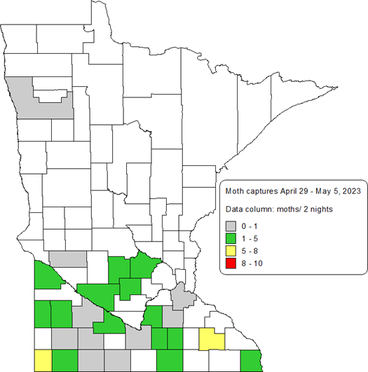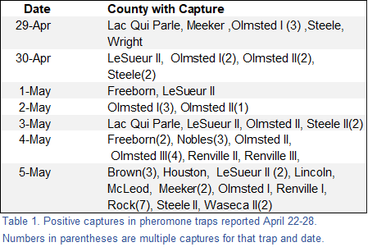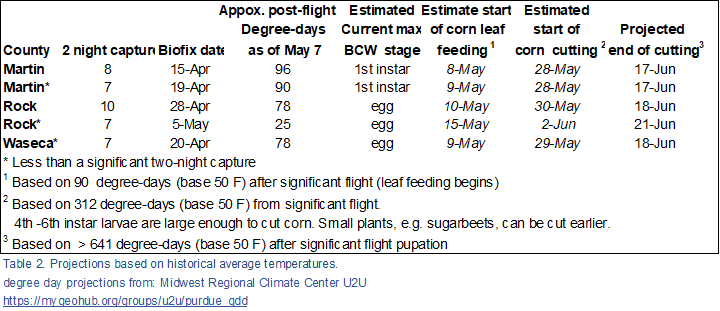2023 University of Minnesota Cooperative Black Cutworm Trapping Network
Report #4 April 29-May 5, 2023
For more information: https://z.umn.edu/bcw-reporting
May 9, 2023
Greetings:

Rapid progress was made in corn planting last week. Tilled fields tend to be less attractive to egg laying black cutworm moths.
Another week of relatively low captures. Several traps picked up a few moths May 4th and 5th. No trap had a significant capture of 8 or moths over a two-night period. The Rock County trap did have a capture of 7 moths on the 5th (Figure 1, Table 1).
Based on accumulated degree days, black cutworm eggs from the earlier significant flights should be hatching soon and the larvae will be large enough to cut small corn the last few days of May (Table 2). Small sugar beets can be killed by small cutworms feeding on the stem below the growing point. Economic injury to soybeans and other crops can also occur.
Based on pheromone trap captures, the southern two tiers of Minnesota appear to be at greatest risk for black cutworm infestations. The weather systems bringing insects from the south tended to be blocked on the north and channeled eastward. Risk can change as moths continue to arrive.

Corn, sugar beet, and soybean fields worked after May 20 are at greater risk of infestation. Early emerging weeds or cover crops can make a field, or areas of a field, more attractive to egg laying black cutworm moths.
The pheromone traps provide little evidence of unusually high risk for black cutworm injury this year. However, trap captures have been extremely spotty, and it is possible that there were moth arrivals that were undetected.

A reminder that crops should be scouted as they emerge, I received my first picture of 2023 emerging corn yesterday. While doing stand counts and weed evaluations, pay close attention to leaf feeding on corn and weeds. Cutworm ID is important as some species (e.g., dingy cutworm) seldom cut corn below the growing point. For more information on scouting tips and management of black cutworm see https://extension.umn.edu/corn-pest-management/black-cutworm
True armyworm pheromone trap captures continue. Typical for Minnesota, the large captures are very sporadic, they might not be closely related to where infestations occur. None of the traps have reported extremely high captures but a trap in Olmsted County captured 33 moths over May 5 to 8. Enough to suggest close attention to corn planted into rye cover crops at rye termination. In addition to spring pheromone results, watch the UMN blacklight trap reporting network (https://vegedge.umn.edu/weekly-moth-flights) for armyworm moth captures. For scouting and management tips for armyworms see https://extension.umn.edu/corn-pest-management/armyworm
Until next week,
Bruce
